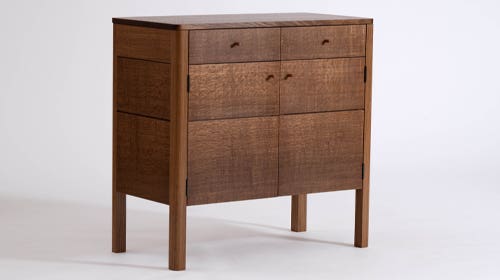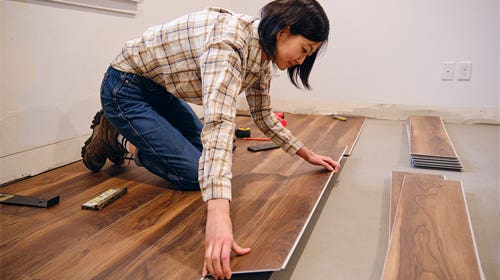Exhibit offers a rare glimpse of Rohlfs
Gustav Stickley, Greene & Greene and Frank Lloyd Wright are iconic names associated with the Arts and Crafts movement, furniture design and architecture that took place at the beginning of…
Gustav Stickley, Greene & Greene and Frank Lloyd Wright are iconic names associated with the Arts and Crafts movement, furniture design and architecture that took place at the beginning of the 20th century. But furniture designer and maker Charles Rohlfs was highly influential at the turn of the century, even if the notoriety he received for his work was short-lived and he discontinued his innovative career after only 10 years.
Now, a little more than a century after Rohlfs abruptly stopped making furniture, the Milwaukee Art Museum is presenting the largest exhibition ever assembled of his work. “The Artistic Furniture of Charles Rohlfs” opens June 6, and is curated by Joseph Cunningham of the American Decorative Art 1900 Foundation, who also authored a book by the same title.
“One of the most important things about Rohlfs is that he was really extraordinarily early in terms of the Arts and Crafts movement evolving in America,” Cunningham says. “His official transfer to furniture making was 1897 and certainly 1897 is before Stickley’s making Arts and Crafts furniture, and before Frank Lloyd Wright is making spindle furniture. He does actually meaningfully precede the explosion of Arts and Crafts oak furniture in America.”
About 40 pieces built by Rohlfs between 1897 and 1907 will be on display, including an assortment of chairs, desks, tables and a plant stand. The complex man was a former actor and industrial designer before spending a decade designing and building furniture. He subsequently moved on to the political arena and was involved in the labor movement.
“He was a studio maker; he worked almost entirely on his own,” Cunningham says. “A couple of years he had a few employees, but quite few, and so he just didn’t make enough to sort of ‘start a movement.’ There wasn’t enough quantity to have it proliferate out into the world enough that he could be credited for any kind of movement like the Mission style.”
Rohlfs is credited for being the earliest design inspiration for Gustav Stickley. His furniture was recognized in the Arts and Crafts style in this country, while more as Art Nouveau from a European perspective.
“Obviously his use of oak and his tendency to show the grain of wood and his tendency toward simplified design certainly is connected to the Arts and Crafts,” Cunningham says. “But on the other hand, his carving is very ornate. There’s a lot of swirling, whiplash that one associates with Art Nouveau in his work as well, so he preferred to avoid all these labels altogether. He wanted his work called the Rohlfs style or artistic furniture. He really wanted to be known as his own designer and he really didn’t want to be part of a movement.”
Ironically, the relatively unknown Rohlfs is well-represented in major museum collections, much more so than Stickley, yet everyone has heard of Stickley and very few have paid attention to Rohlfs. So what is the appeal of furniture created by Rohlfs?
“I think the eclecticism,” says Cunningham. “I think it is this radical willingness that he had to try a different thing almost every time he sat down to make a piece of furniture ... Every time I get to see a piece of Rohlfs’s furniture, it’s somehow unlike every other piece I’ve ever seen. So I think it’s particularly exciting in its inventive, expressive nature.”
And the question, which one can only wonder about, is what impact Rohlfs would have had on 20th century furniture if he continued his career.
“I think some people, you know, their candle burns very bright for a very short time,” reflects Cunningham. “I’m not sure how many more ideas he would have had, but it is sort of a question we would never know the answer to. There’s a very interesting question about whether or not the compactness of his career, the fact that he basically only made furniture for about a decade, actually made him more experimental or whether or not he would have had another 10 or 20 years of interesting ideas.”
The traveling exhibition will close Aug. 23 in Milwaukee and move to venues in Dallas, Pittsburgh, San Marino, Calif., and New York.
NWA Showcase
The 18th annual Woodworkers Showcase 2009 and Totally Turning 2009 will be held March 28-29 at the Saratoga Springs City Center in Saratoga Springs, N.Y. This annual event, sponsored by the Northeastern Woodworkers Association, is an opportunity for artisans to display their work in handmade furniture, wood turning, carving, scroll sawing and other areas.
This year’s professional guests are Adam Cerubini, a period furniture maker from Cinnaminson, N.J.; W. Patrick Edwards, furniture restorer, inlay artist, and founder of the American School of French Marquetry in San Diego; Jim Tolpin, woodworker, author and teacher at Port Townsend School of Woodworking in Port Townsend, Wash.; and Molly Winton, a woodturner from Edmonds, Wash.
Elsewhere
The Society of Arts and Crafts in Boston, in conjunction with Craft in America at the Fuller Craft Museum, is presenting “Craft in America: Focus on Wood” through April 19. The exhibition explores the formal and conceptual possibilities of wood by 13 contemporary American artists in the areas of studio furniture, sculpture, turned vessels and jewelry. Exhibiting artists are Michael DeForest, Ashley Jameson Eriksmoen, Charles Faucher, Mark Gardner, Duncan Gowdy, Miki Iwasaki, Christine Lee, Emi Ozawa, Matthias Pliessnig, Jason Schneider, Joël Urruty and Leah Woods.
Contacts
Milwaukee Art Museum, 700 N. Art Museum Dr., Milwaukee, WI 53202. Tel: 414-224-3200. www.mam.org
Northeastern Woodworkers Association, P.O. Box 246, Rexford, NY 12148, Tel: 518-370-0388. www.nwawoodworkingshow.org or www.woodworker.org
Society of Arts & Crafts, 175 Newbury St., Boston, MA 02116. Tel: 617-266-1810. www.societyofcrafts.org
This article originally appeared in the March 2009 issue.







